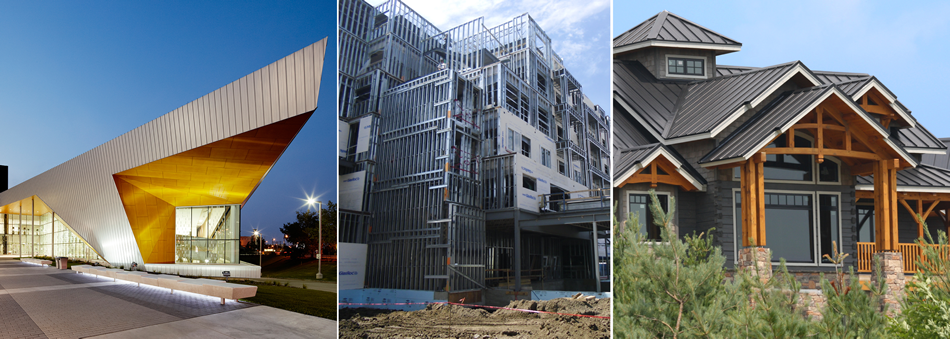These are the results of a study conducted by Ducker Research Company1 for the National Roofing Contractors Association (NRCA). The purpose of the study was to compare three commonly used types of low slope roofing systems (2:12 roof slope or less) from the standpoints of service life, maintenance cost, and overall life cycle cost.
The study looked at the following three different roofing types:
- Metal (mostly unpainted coated steel roofs)
- Built Up Roofs (BUR) - modified bitumen, asphalt
- Single ply membrane (EPDM/PVC/TPO)
Four different building categories were surveyed:
Based on 41 plus interviews with building owners and managers, 36 case studies of roofing systems were selected from the western, northern and southern regions of the United States. In all, twelve case studies were evaluated on each of the three roofing types. Steel comprised the vast majority of the metal roofing systems.2 Most of the roofs were installed between 1981 and 1994; roof areas varied from 4,000 to 750,000 square feet with the average being approximately 92,000 square feet. The expected service life of steel roofing was determined to be 40 years – 17 years longer that Built Up Roofs and 20 years longer than Single Ply systems (see Figure 1).
- Office/Bank
- Retail (store, mercantile)
- Manufacturing (industrial, warehouse)
- Institutional (education, healthcare, hotel/motel)
Based on 41 plus interviews with building owners and managers, 36 case studies of roofing systems were selected from the western, northern and southern regions of the United States. In all, twelve case studies were evaluated on each of the three roofing types. Steel comprised the vast majority of the metal roofing systems.2 Most of the roofs were installed between 1981 and 1994; roof areas varied from 4,000 to 750,000 square feet with the average being approximately 92,000 square feet. The expected service life of steel roofing was determined to be 40 years – 17 years longer that Built Up Roofs and 20 years longer than Single Ply systems (see Figure 1).
Life Cycle Cost: All relevant aspects of low-slope roofing were considered: roof design, number of layers, sheet gauge, standing seam or through-fastened, insulation type and thickness, installation systems (i.e. seamed, ballasted, etc.), labour, balance of systems (i.e. venting, parapets, etc.), geographical effects, life span and additional items relating to the full life cycle, as well as the original installation cost.
Steel roofing has two characteristics that the other two roofing materials do not:
- Steel is a non-porous material and under some conditions requires no underlayment to keep the building dry
- Steel is easily engineered to withstand increased gravity and wind loads
Service life, durability and life cycle cost are considered the most important criteria in the selection of roofing type, according to building owners. While the majority of buildings had experienced roof leaks, none of the steel roofs had leaked as a result of material failure. By comparison, 30% of the Built Up Roofs and 56% of the Single Ply roofs experienced leaks resulting from material failure.
Furthermore, owners of buildings having steel roofs reported having little or no regular maintenance performed on their roofs. The leaks reported on steel roofing were a result of contractor installation problems. Regardless of roofing type, failure to achieve a quality installation is the primary reason for roof failure. (see Figures 2 and 3)
The Ducker Research Company study showed that the life cycle cost of a metal roof is significantly less than BUR and Single Ply roofing. Steel roofing had the lowest maintenance costs and had, on average, a 17+ year greater lifespan than the other two roofing systems. The study also concluded that
building owners believe that service life and life cycle costs are the most important factors in roofing material selection and overall, metal roofing is by far the best option based on its lowest life cycle cost. Add to this the fact that steel roofing is 100% recyclable, has industry leading recycled content and easily qualifies for LEED Canada certification.






Steel roofing is a kind of metal roofing similar to roofs made of zinc, aluminum, terna, etc. They are lightweight and easy to install when compared to slate roofing or other conventional roof systems.
ReplyDeleteIko Shingles
This article makes a great case for metal roofing. My boss just bought an old office building and he wants to replace the roof. Maybe he should consider a metal roof?
ReplyDeleteSusan Hirst | http://www.aclark.ca/edmonton/services/roofing/metal
Yes a low slope steel roof would be an excellent idea. If the roof is already sloped then it should be a straightforward replacement. If it is a flat roof though, there are systems that can be used to retrofit the roof to have a low slope using steel.
DeleteThanks for the analytics study regarding the low slope roofing. It is a far more efficient idea than other roofing systems in many situations. Bronx Roofers
ReplyDeleteAppreciating the time and energy you put into your blog and detailed information you offer. It’s awesome to come across a blog every once in a while that isn’t the same unwanted rehashed material. Great read! I’ve saved your site and I’m including your RSS feeds to my Google account.
ReplyDeleteThank you for your comment. We have actually moved our blog into the CSSBI website. You can find it here http://www.cssbi.ca/blog update your RSS feed and you can stay in the loop.
Delete